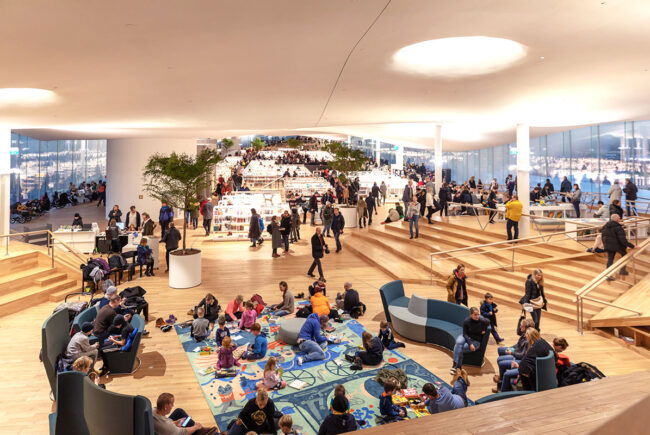

The year old Central Library Oodi in Helsinki, is more than a place to borrow books from. It is a learning environment and venue for events and gatherings.
The year old Central Library Oodi in Helsinki, is more than a place to borrow books from. It is a learning environment and venue for events and gatherings.
What if the whole city was a lifelong learning space in itself? The Finnish capital Helsinki is aiming to lead the way in this.
Pia Pakarinen, the Deputy Mayor for Education and Education in the City of Helsinki, recently met the youngest client in her field: a 12–day–old baby who was in the playground with her mother.
“A playground is an oasis for being together. There, parents do things, learn with their child and also receive support from other parents,” Pakarinen says.
Learning is strongly involved in Helsinki’s urban strategy. The Finnish capital aims to become an innovative pilot city for lifelong learning, utilising the entire city as a learning space for all ages.
“We want to be a testing ground for all kinds of experiments.”
In order to achieve that, digitalisation can help.
When schoolchildren leave the classroom, they carry around their mobile phones or tablets. Students get assignments from an app, and there are even apps that let the teacher know where the students are.
Pakarinen emphasises that digitalisation is a tool that supports learning. At its simplest, this can mean taking photos, for example.
“On a traditional forest trip, children encounter all sorts of bugs, and they don’t know immediately what they are. But if they take a picture, they can search for more information after the hike about the animals or phenomena documented during it,” she says.
School is changing
In Finland, the new 2016 curriculum has brought to the fore phenomenon-based learning. During phenomenon-based weeks, students study topics of their choosing across the traditional school subject boundaries.
Even the new school buildings are different from the old ones, as students may not have their own classrooms. At the same time, there are more moments for learning outside the school.
One part of civic competence is being able to move outside your own neighborhood.
“Those who have just started school will still be in the workforce in the 2070s. When working life changes, we cannot think that school won’t change in any way,” says Pakarinen.
In addition, in the Helsinki metropolitan area, school classes can board any public transport during the day without paying for it.
“There are many children who never visit downtown Helsinki with their parents. One part of civic competence is being able to move outside your own neighborhood. Going downtown and exploring cultural and artistic institutions is important in itself.”
Libraries have it all
Libraries have traditionally been among the cornerstones of Finnish democracy. Many of the excursions undertaken by Helsinki-based schoolchildren are directed at the new Oodi Central Library.
Pia Pakarinen emphasises, that Oodi is more a learning environment and venue for events and gatherings than the site of a traditional collection of books to borrow.
Pasi Mäenpää, Associate Professor of Urban Sociology at the University of Helsinki agrees.
“Oodi is an expanded public space that could be compared to the Stockholm Kulturhuset, for example,” he says.
“The library is so self-evident that at first it did not even occur to me that it was a learning environment. But if a foreign urban sociologist came in, they would definitely praise it.”
Suitable locations for urban learning
Pia Pakarinen, Deputy Mayor for Education and Training, Helsinki:
- Nature. “Getting to know it starts in kindergarten.”
- Oodi. “All libraries are important.”
- Art museums. “Digital tools help people to explore both nature and museums more broadly.”
Pasi Mäenpää, Associate Professor of Urban Sociology, University of Helsinki:
- The city itself. “A good city is a place where a child can walk around and decide what they want to be when they grow up.”
- The new elementary school in Jätkäsaari. “A school without corridors, where the students are not in classrooms, but in different learning spaces.”
- Espoo Opinmäki Learning Center. “Extended learning environment.”
Author







